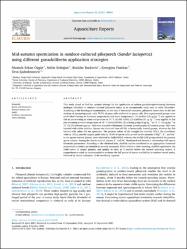| dc.contributor.author | Özgür, Mustafa Erkan | |
| dc.contributor.author | Erdoğan, Selim | |
| dc.contributor.author | Rašković, Božidar | |
| dc.contributor.author | Fazekasd, Georgina | |
| dc.contributor.author | Ljubobratovićd, Uroš | |
| dc.date.accessioned | 2021-11-23T12:10:01Z | |
| dc.date.available | 2021-11-23T12:10:01Z | |
| dc.date.issued | 2021 | en_US |
| dc.identifier.citation | Özgür, M. E., Erdoğan, S., Rašković, B., Fazekas, G., & Ljubobratović, U. (2021). Mid-autumn spermiation in outdoor-cultured pikeperch (Sander lucioperca) using different gonadoliberin application strategies. Aquaculture Reports, 21, 100891. | en_US |
| dc.identifier.issn | 10.1016/j.aqrep.2021.100891 | |
| dc.identifier.uri | https://doi.org/10.1016/j.aqrep.2021.100891 | |
| dc.identifier.uri | https://hdl.handle.net/20.500.12899/485 | |
| dc.description.abstract | This study aimed to find the optimal strategy for the application of salmon gonadotropin-releasing hormone analogue (sGnRHa) in outdoor-cultured pikeperch males in an exceptionally early term in early November. According to the histological examination, on the day of hormonal treatment, pikeperch testes were in the late stadium of spermatogenesis, with 78.7% of germ cells attributed to sperm cells. Five experimental groups were established varying on hormonal preparations and water temperature: (1) sGnRHa (25 μg kg−1) was applied to fish at pre-warming at water temperature of 11 °C (GnRH-LOW); (2) sGnRHa (25 μg kg−1) was applied to fish post-warming at water temperature of 15 °C (GnRH-HIGH); (3) priming group (5 μg kg−1 at 11 °C +25 μg kg−1 at 15 °C); (4) reference group – fish were injected with human chorionic gonadotropin; (5) control group - fish were injected with saline solution. Sperm was obtained from all fish in hormonally treated groups, whereas the fish treated with saline did not spermiate. The greatest values of the straight-line velocity (VSL), the curvilinear velocity (VCL), and the angular path velocity (VAP) of sperm cells, as well as the amounts of Mg2+, K+, and Na+ in the sperm seminal plasma, were obtained in GnRH-HIGH, whereas the GnRH-LOW group yielded the greatest sperm volume. Among the ions in seminal plasma, K+ and Na+ dominated and showed a relationship with sperm kinematic parameters. According to the obtained data, sGnRHa can be considered as an appropriate hormonal preparation to induce spermiation at an early preseason. Either before or after warming, sGnRHa application can yield sperm of proper quantity and quality as early as 5 months before the natural spawning season. A comprehensive study is recommended to evaluate the full period of sperm availability in outdoor-reared males, followed by direct evaluation of the fertilizing capacity. | en_US |
| dc.language.iso | eng | en_US |
| dc.publisher | Elsevier | en_US |
| dc.relation.isversionof | 10.1016/j.aqrep.2021.100891 | en_US |
| dc.rights | info:eu-repo/semantics/openAccess | en_US |
| dc.subject | Sperm cell kinematics | en_US |
| dc.subject | Seminal plasma ions | en_US |
| dc.subject | GnRH | en_US |
| dc.subject | Artificial reproduction | en_US |
| dc.subject | Testis histology | en_US |
| dc.title | Mid-autumn spermiation in outdoor-cultured pikeperch (Sander lucioperca) using different gonadoliberin application strategies | en_US |
| dc.type | article | en_US |
| dc.authorid | 0000-0002-2966-9627 | en_US |
| dc.department | MTÖ Üniversitesi, Doğanşehir Vahap Küçük Meslek Yüksekokulu, Yönetim ve Organizasyon Bölümü | en_US |
| dc.contributor.institutionauthor | Özgür, Mustafa Erkan | |
| dc.identifier.volume | 21 | en_US |
| dc.identifier.startpage | 1 | en_US |
| dc.identifier.endpage | 10 | en_US |
| dc.relation.publicationcategory | Makale - Uluslararası Hakemli Dergi - Kurum Öğretim Elemanı | en_US |


















